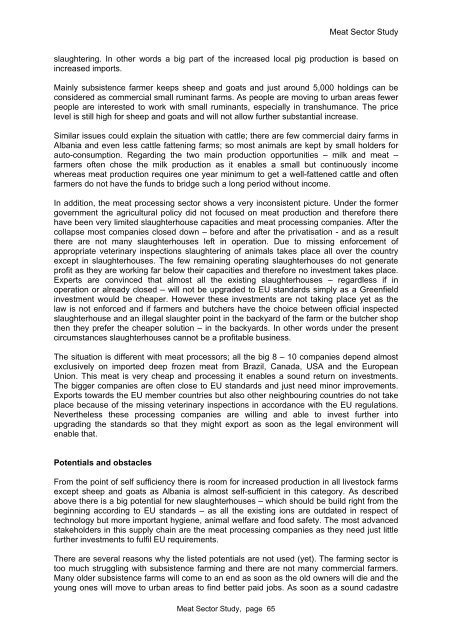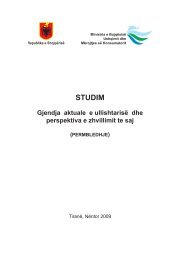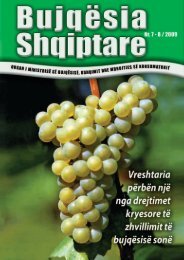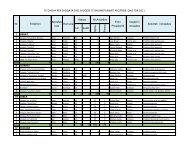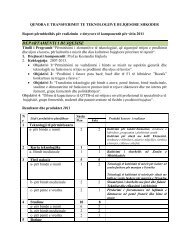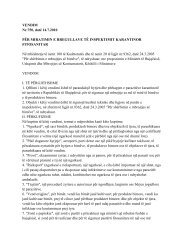MEAT Sector Analyse
MEAT Sector Analyse
MEAT Sector Analyse
- TAGS
- sector
- analyse
- mbumk.gov.al
Create successful ePaper yourself
Turn your PDF publications into a flip-book with our unique Google optimized e-Paper software.
Meat <strong>Sector</strong> Study<br />
slaughtering. In other words a big part of the increased local pig production is based on<br />
increased imports.<br />
Mainly subsistence farmer keeps sheep and goats and just around 5,000 holdings can be<br />
considered as commercial small ruminant farms. As people are moving to urban areas fewer<br />
people are interested to work with small ruminants, especially in transhumance. The price<br />
level is still high for sheep and goats and will not allow further substantial increase.<br />
Similar issues could explain the situation with cattle; there are few commercial dairy farms in<br />
Albania and even less cattle fattening farms; so most animals are kept by small holders for<br />
auto-consumption. Regarding the two main production opportunities – milk and meat –<br />
farmers often chose the milk production as it enables a small but continuously income<br />
whereas meat production requires one year minimum to get a well-fattened cattle and often<br />
farmers do not have the funds to bridge such a long period without income.<br />
In addition, the meat processing sector shows a very inconsistent picture. Under the former<br />
government the agricultural policy did not focused on meat production and therefore there<br />
have been very limited slaughterhouse capacities and meat processing companies. After the<br />
collapse most companies closed down – before and after the privatisation - and as a result<br />
there are not many slaughterhouses left in operation. Due to missing enforcement of<br />
appropriate veterinary inspections slaughtering of animals takes place all over the country<br />
except in slaughterhouses. The few remaining operating slaughterhouses do not generate<br />
profit as they are working far below their capacities and therefore no investment takes place.<br />
Experts are convinced that almost all the existing slaughterhouses – regardless if in<br />
operation or already closed – will not be upgraded to EU standards simply as a Greenfield<br />
investment would be cheaper. However these investments are not taking place yet as the<br />
law is not enforced and if farmers and butchers have the choice between official inspected<br />
slaughterhouse and an illegal slaughter point in the backyard of the farm or the butcher shop<br />
then they prefer the cheaper solution – in the backyards. In other words under the present<br />
circumstances slaughterhouses cannot be a profitable business.<br />
The situation is different with meat processors; all the big 8 – 10 companies depend almost<br />
exclusively on imported deep frozen meat from Brazil, Canada, USA and the European<br />
Union. This meat is very cheap and processing it enables a sound return on investments.<br />
The bigger companies are often close to EU standards and just need minor improvements.<br />
Exports towards the EU member countries but also other neighbouring countries do not take<br />
place because of the missing veterinary inspections in accordance with the EU regulations.<br />
Nevertheless these processing companies are willing and able to invest further into<br />
upgrading the standards so that they might export as soon as the legal environment will<br />
enable that.<br />
Potentials and obstacles<br />
From the point of self sufficiency there is room for increased production in all livestock farms<br />
except sheep and goats as Albania is almost self-sufficient in this category. As described<br />
above there is a big potential for new slaughterhouses – which should be build right from the<br />
beginning according to EU standards – as all the existing ions are outdated in respect of<br />
technology but more important hygiene, animal welfare and food safety. The most advanced<br />
stakeholders in this supply chain are the meat processing companies as they need just little<br />
further investments to fulfil EU requirements.<br />
There are several reasons why the listed potentials are not used (yet). The farming sector is<br />
too much struggling with subsistence farming and there are not many commercial farmers.<br />
Many older subsistence farms will come to an end as soon as the old owners will die and the<br />
young ones will move to urban areas to find better paid jobs. As soon as a sound cadastre<br />
Meat <strong>Sector</strong> Study, page 65


